Public Participation and Community Engagement: Local Government Sector
Overview
The local government sector is a significant part of the Victorian economy—the state’s 79 local councils employ over 50 000 people, spend around $7 billion on service delivery and $2 billion on infrastructure annually, and manage over $70 billion in public assets.
Councils make decisions about a diverse range of community needs, such as recreational facilities, planning and waste disposal. To cater for these needs, transparent and well-managed public participation can help to better inform local government policies and their translation into effective strategies, programs and projects.
In this audit, we examined the effectiveness of community engagement and participation at the local government level. We looked at public participation at six councils, including a mix of metropolitan, rural and regional councils, as well as Local Government Victoria’s role in supporting councils’ public participation activities.
We assessed public participation as part of the budget process, as an element in the development of council plans, and as an investment decision for each council.
We make three recommendations to all local councils in Victoria and one for the Department of Environment, Land, Water and Planning.
Public Participation and Community Engagement: Local Government Sector: Message
Ordered to be published
VICTORIAN GOVERNMENT PRINTER May 2016
PP No 251, Session 2014-2017
President
Legislative Council
Parliament House
Melbourne
Speaker
Legislative Assembly
Parliament House
Melbourne
Dear Presiding Officers
Under the provisions of section 16AB of the Audit Act 1994, I transmit my report Public Participation and Community Engagement: Local Government Sector.
Yours faithfully

Andrew Greaves
Auditor-General
10 May 2016
Audit overview
The local government sector is a significant part of the Victorian economy—the state's 79 local councils employ over 50 000 people, spend around $7 billion on service delivery and $2 billion on infrastructure annually, and manage over $70 billion in public assets.
Victoria's councils are supported by Local Government Victoria (LGV)—part of the Department of Environment, Land, Water and Planning. LGV works cooperatively with councils to ensure Victorians benefit from responsive and accountable local government. In partnership with councils, LGV works to improve business and governance practices to maximise community value and accountability, and oversees the administration of the relevant legislation.
Councils make decisions about a diverse range of community needs, such as recreational facilities, planning and waste disposal. To cater for these needs, transparent and well-managed public participation can help to better inform local government policies and their translation into effective strategies, programs and projects.
The real-life experiences of community stakeholders can make a valuable contribution to decision-making, and an open and deliberative process can enhance stakeholders' perceptions of the credibility of a decision. Conversely, inadequate public participation can alienate sections of the community and undermine trust, and is more likely to result in poorly informed decisions.
In this audit, we examined the effectiveness of community engagement and participation at the local government level. We looked at public participation at six councils, including a mix of metropolitan, rural and regional councils, as well as LGV's role in supporting councils' public participation activities. We assessed public participation as part of the budget process, as an element in the development of council plans, and as an investment decision for each council.
Councils' approach to public participation should reflect the scale, purpose and level of public interest in the council decision or project. Regardless of the size of the project, we would expect to see documented evidence that councils have understood and appropriately taken into account better practice principles when designing and implementing their public participation activities.
We used the International Association for Public Participation (IAP2) model of public participation in our assessments. IAP2 specifies five levels of public engagement:
- Inform and Consult—these first two levels typically occur when a council has already made a decision and wants to either communicate that decision to the community, or seek opinions on the decision.
- Involve and Collaborate—the third and fourth levels involve a two-way flow of information, when a council shares information within and across stakeholder groups during the decision-making process.
- Empower—the fifth level is when the council and the community jointly make decisions.
Conclusion
The councils we audited typically have strong public participation frameworks that provide them with the tools they need to undertake better practice consultation. However, councils do not routinely apply these tools in all of their public participation activities. Councils do not have adequate processes for documenting and evaluating these activities, which compromises the value of councils' public participation practices.
LGV demonstrates better practice in its own public participation activities. However, it does not provide enough support and guidance to help councils address the relatively low levels of satisfaction that communities express about their public participation. In its role of working with councils to improve practices and maximise community value, LGV could do more to identify specific weaknesses in public participation and promote better practice across councils.
Findings
Policies, frameworks and staff resources
Councils have a range of public participation policies, frameworks and guides for their staff, which set out expectations for public participation and contain guidance on the various elements of public participation. These guides and associated resources articulate councils' commitment to high-quality, consistent and genuine community engagement.
Five of the six audited councils have a public participation policy or framework that is informed by the internationally recognised IAP2 model of public participation. Despite this, there is considerable variation in the quality and implementation of councils' public participation policies, and some do not provide enough practical guidance for their staff to effectively conduct public participation activities.
By comparing the audited councils' public participation policies, we identified 12 common elements of better practice. Half of the audited councils need to review their public participation policies and include more better practice components. In particular, the policies of three councils did not have the fundamental elements of when, how and who to engage.
Five of the six councils have a public participation staff guide, handbook or templates. We identified 15 common elements of better practice by comparing audited councils' guides and resources. The quality of these resources varied significantly across the councils. For example, one council had limited website resources available to staff, while another council had a comprehensive staff handbook divided into four key areas—the council's approach to public participation, planning to engage, engaging with stakeholders and methods of engaging.
Only one project from an audited council had a comprehensive community engagement plan. A second council had a plan but had missed the essential element of evaluation. These plans included better practice elements, such as having a fully informed description of the planned objectives and scope of public participation, and identifying the stakeholders, the resources and skills needed, the time frame required, and the evaluation criteria.
Despite having public participation policies and resources in place, four councils did not have a community engagement plan for the projects we examined. This means they were unable to demonstrate the effectiveness and efficiency of their public participation exercises. These councils would benefit from developing a comprehensive engagement plan, including a step-by-step guide to effective public participation based on better practice principles, to help them conduct more effective public participation activities.
Evaluation
The audited councils typically evaluate public participation using quantitative measures such as the number, type and outcomes of public participation events, the number of participants, and social media statistics. They did not generally evaluate projects using qualitative information collected through interviews, focus groups or open-ended survey questions.
Useful qualitative information includes:
- whether the public participation activities used the most suitable and effective techniques
- whether the public participation activities were conducted effectively
- whether the engagement was cost-effective and timely
- what impact the engagement had on decision-making
- whether people from all participant groups felt that they were listened to.
Incorporating these qualitative responses would provide councils with more complete information to use as a basis for effectively evaluating their public participation activity.
Budgets and council plans
All of the audited councils fulfilled their statutory obligations for public participation in their council budgets and council plans, although we found that three councils had already made their decisions before conducting the public participation activities, and they simply wanted to communicate that decision to the public, or seek opinions on the decision.
This practice is at the lowest end of the IAP2 spectrum—Inform. This approach increases the risk that the community will perceive that they have not been able to have a say in the budget preparation process.
In contrast, we found better practice examples at three councils that engaged their communities meaningfully in the budget decision-making process. One council sought the community's views on the projects to be selected for funding, another allowed the community to identify budget priorities, and a third used a live social media event to facilitate discussion on the budget. While the live event received positive comments from participants, the other two councils did not evaluate the success of their activities.
These public participation activities are at the Consult end of the IAP2 spectrum, which means that they aim to obtain feedback on analysis, alternatives and decisions.
Community plans
A community plan describes the community's long-term vision and aspirations, and is a way of directly involving the community in the council planning process. Two audited councils undertook major community consultation processes to develop long-term community plans.
In both cases, the councils worked with the public to ensure that community concerns and aspirations were understood and considered. They demonstrated a genuine commitment to work with the public to exchange information, and to seek advice and ideas from the community. They used a variety of communication strategies, with the aim of maximising participation across different groups within the community. These included postcards, websites, social media, events and stalls, written submissions, workshops and focus groups. Importantly, they used stakeholder feedback to shape the community plan.
These large-scale participation activities fall into the Involve and Collaborate stages of the participation spectrum. They ensure the purpose of the communication is clear, and that the council works with the community to formulate decisions.
Public participation in other council activities
The audited councils provided evidence of public participation in a wide range of community projects and at different points on the participation spectrum. They used a variety of methods and activities to engage the community, depending on the project and group involved, including surveys, focus groups, social media, submissions, community events, community liaison groups and community workshops. One council provided an example of participation at the fifth level of the participation spectrum, Empower, where the community played a key role in implementing a local initiative.
None of the councils we audited had evaluated their projects to measure the outcomes of the public participation exercise against the objectives, nor had they documented any lessons and recommendations for improvement. By not monitoring and evaluating these activities, councils have no evidence to demonstrate their effectiveness.
Sector leadership
In 2016,LGV provided leadership for public participation by developing a discussion paper on its review of the Local Government Act 1989. LGV considered input from six technical groups and nine community workshops, and received 328 submissions. The resulting directions paper Act for the Future proposes a much stronger role for public participation in local government, in line with IAP2 better practice. It proposes ways to build stronger public engagement in shaping councils' directions and developing council plans. It also outlines ways for councils to ensure that they are transparent and accountable, and to ensure they have a rigorous approach for responding to community complaints.
LGV uses an annual community satisfaction survey to collect information on councils' public participation performance. The survey has found that community satisfaction with councils' community consultation and engagement was satisfactory in 2015–16, with an overall score of 55 out of 100, but could be improved by councils consulting and engaging directly with the community on key local issues. LGV reports summarised findings back to the sector, but it does not analyse in depth the public participation and engagement activities. Conducting a more thorough analysis of the data would help LGV to develop resources and initiatives that support councils to improve their practices.
LGV demonstrated its own public participation processes in the development of the Victorian Aboriginal Local Government Action Plan, the Local Government Model Financial Report and the Geelong citizens' jury. These projects employed a range of better practice elements for consultation including surveys, establishment of a user group, focus groups, formal submissions and workshops. However, LGV did not evaluate the outcomes of these initiatives, and we are therefore unable to determine whether these methods were successful.
Recommendations
We recommend that all councils:
1. assess their public participation policies and associated resources against the International Association for Public Participation (IAP2) model, update them as necessary, and promote their use throughout the council (see Section 2.2)
2. build monitoring, reporting and evaluation activities into their public participation activities (see Section 2.2)
3. develop and document comprehensive public participation plans and their outcomes (see Section 2.7).
We recommend that the Department of Environment, Land, Water and Planning:
4. analyse public participation data and promulgate better practice public participation case studies, guidance and training (see Section 3.4).
Responses to recommendations
We have consulted with Local Government Victoria (within the Department of Environment, Land, Water and Planning), the City of Ballarat, Cardinia Shire Council, Maribyrnong City Council, Maroondah City Council, Mitchell Shire Council and Murrindindi Shire Council, and we considered their views when reaching our audit conclusions. As required by section 16(3) of the Audit Act 1994, we gave a draft copy of this report to those agencies and asked for their submissions and comments. We also provided a copy to the Department of Premier and Cabinet.
The following is a summary of those responses. The full responses are included in Appendix A.
The Department of Environment, Land, Water and Planning supported our recommendations and provided an action plan for how it will implement the recommendation made to it. The City of Ballarat, Cardinia Shire Council, Mitchell Shire Council and Murrindindi Shire Council also supported our recommendations. Maribyrnong City Council responded that different councils are at different stages of implementing their policies and framework.
1 Audit context
Victoria's local government sector, comprising 79 councils, has a significant impact on the lives of all Victorians. Councils are established by the Local Government Act 1989 (the Act), which specifies councils' powers, duties and functions.
Councils are area-based, representative governments with a legislative and electoral mandate to manage local issues and plan for their communities' needs. Councils manage community infrastructure and assets worth more than $70 billion, such as local roads, bridges, recreational and leisure facilities, and footpaths. They provide more than 100 types of services for people who live in, work in and visit the local area, including waste management, animal management and health and community services.
Public participation—the involvement of those affected by a decision in the decision‑making process—is increasingly recognised as an essential part of government at all levels, including local government. Public participation encompasses a range of public involvement, from simply informing people about what government is doing to delegating decisions to the public.
Incorporating public input into local government decision-making can provide insights into possible problems and risks during project planning, and ensures that community concerns are taken into account. This results in decisions that are more likely to be widely accepted and deliver good results.
1.1 Guidance and better practice principles
VAGO released its better practice guide Public Participation in Government Decision‑making in January 2015. The guide is based on the International Association for Public Participation (IAP2) model of public participation.
Our guide summarises recognised better practices for public participation and activities to inform government decisions. It also provides a clear, high-level structure and criteria for managing public participation exercises.
IAP2's public participation spectrum includes five levels of public engagement, outlined in Figure 1A. The first two are described as 'Participation' and the next two as 'Engagement'. There is a significant difference in decision-making authority between the spectrum's fifth level of public participation, Empower, and the other levels—at this level, decisions are made jointly by the government and the community.
Each level of participation has merit, depending on the aim of the public participation activity. If the goal is to keep the public informed or to listen to and acknowledge the public's concerns, then the first two levels of participation would be suitable. If the goal is to work with the public to exchange information, ideas and concerns, or to seek advice and innovations, then an Involve, Collaborate or Empower level of participation would be more suitable.
Figure 1A
The five levels of public participation
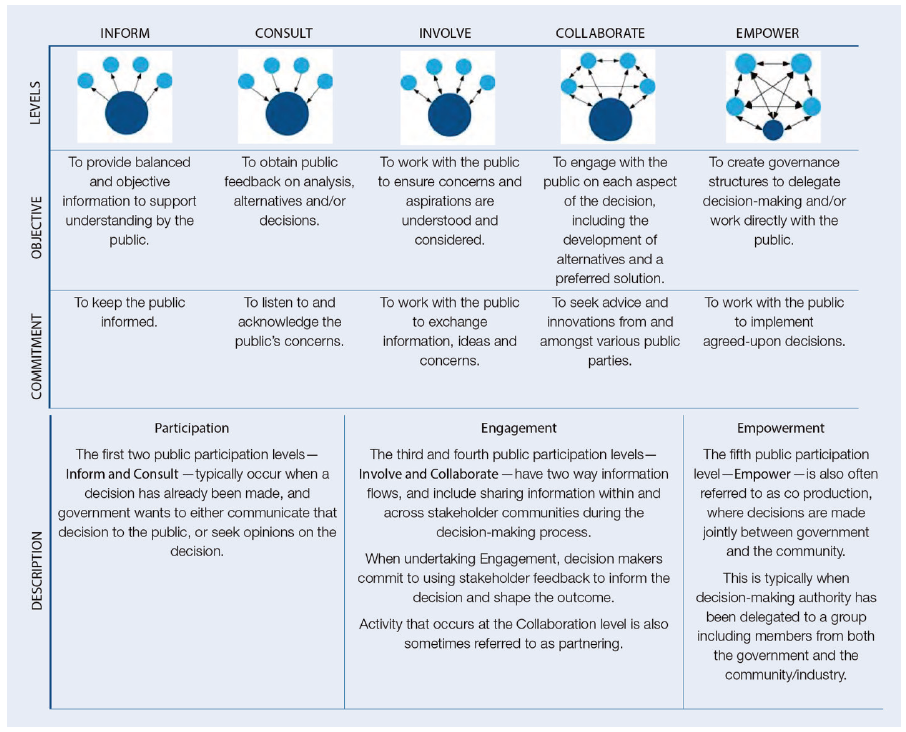
Source: VAGO, Public Participation in Government Decision-making, January 2015, adapted from IAP2.
1.2 Legislative requirements
The Act requires community participation in the development of councils' plans and budgets, and in councils' application for an exemption to the rate cap.
1.2.1 Council plans and budgets
A council must prepare and approve a council plan within six months after each general election or by the next 30 June, whichever is later. A council plan must include:
- the strategic objectives of the council
- strategies for achieving the objectives for at least the next four years
- strategic indicators for monitoring the achievement of the council's objectives
- a strategic resources plan
- any other matters prescribed by the Local Government Regulations.
A council must also prepare a budget for each financial year setting out:
- the standard financial statements in the prescribed format and containing the information required by the Local Government Regulations
- a description of the activities and initiatives to be funded in the budget
- a statement describing how the activities and initiatives will help the council achieve the strategic objectives specified in its plan
- key strategic activities that the council will undertake during the financial year, and performance targets and measures for each key strategic activity
- any other details required by the regulations.
Under the Act, community members have a right to make a submission on the proposed council plan and the proposed budget. To enable this, the Act requires each council to publish a public notice and make a copy of the proposed council plan and budget available for inspection at the council office and any district offices for 28 days after the public notice is published. The proposed council plan and budget must also be published on the council's website.
These obligations establish the minimum public participation requirements for councils.
1.2.2 Council rates
In Victoria, council rates can comprise up to three components:
- a municipal charge—not more than 20 per cent of a council's total rates revenue
- a waste management charge
- a rate in the dollar based on a residence's property value.
In 2015, the Victorian Government introduced rate capping legislation—the Fair Go Rates System (FGRS). Under this system, the Minister for Local Government sets an annual rate cap, which controls increases in rates during that financial year. Councils can seek approval from the Essential Services Commission (ESC) to increase their rates above the cap.
A council applying to the ESC for an exemption to the rate cap must first engage the local community. One of the criteria for an exemption is how the council has taken into account the views of ratepayers and the community in proposing the higher rate increase. This criterion emphasises the importance of public participation, particularly the need to meaningfully consider community feedback.
1.2.3 Review of the Local Government Act 1989
The Act is currently under review. The proposed amendments aim to improve the transparency, responsiveness and collaborative capacity of councils, and to reinforce participatory democracy as a guiding principle of council practice.
Local Government Victoria's (LGV) directions paper Act for the Future: Directions for a new Local Government Act outlines the proposed public participation requirements in the revised Act, shown in Figure 1B.
Figure 1B
Proposed directions for community participation
in the revised Local Government Act
|
Source: VAGO, based on Department of Environment, Land, Water and Planning, Act for the Future: Directions for a new Local Government Act, 2016, page 61.
The proposed directions are more specific than those in the current Act, and reflect the growing importance of public participation in government decision-making.
1.3 Local Government Victoria
LGV is part of the Department of Environment, Land, Water and Planning and works cooperatively with Victoria's 79 local councils to ensure Victorians benefit from responsive and accountable local government. In partnership with the local government sector, LGV works to improve business and governance practices to maximise community value and accountability, and oversees the administration of the relevant legislation.
Although LGV has a general role in working with councils to improve the way they operate, it does not have a specific role in directing or overseeing councils' public participation activities, and has not conducted any public participation projects or initiatives.
1.4 Why this audit is important
Public participation and engagement by local councils is of significant interest to the community and of great importance, particularly as inadequate consultation can lead to poor decisions by councils.
Transparent and well-managed public participation can help to better inform local government policies and their application through effective strategies, programs and projects.
This audit outlines areas for local government to improve its performance in managing public participation and community engagement.
1.5 What this audit examined and how
In this audit, we examined the effectiveness of community engagement and participation at the local government level.
We examined councils' public participation processes for significant activities, such as developing the council budget and council plan, and making major investment decisions. We benchmarked these processes against better practice principles, in line with IAP2.
Alongside LGV, we selected six councils to audit:
- two metropolitan councils—Maroondah City Council and Maribyrnong City Council
- one interface council (one of the nine municipalities that form a ring around metropolitan Melbourne)—Cardinia Shire Council
- one regional city council—City of Ballarat
- one large shire council—Mitchell Shire Council
- one small shire council—Murrindindi Shire Council.
We conducted this audit in accordance with section 15 of the Audit Act 1994 and Australian Auditing and Assurance Standards. The cost of this audit was $490 000.
1.6 Report structure
The remainder of this report is structured as follows:
- Part 2 looks at public participation in council activities
- Part 3 looks at LGV's role in public participation.
2 Public participation in council activities
Public participation is a critical part of government decision-making at all levels. Community engagement helps councils to develop effective strategies, programs and projects. Councils that fail to adequately engage the public risk alienating the community and creating adverse impacts through poorly informed and implemented decisions.
Better practice elements of public participation include developing clear objectives, properly understanding the problem, objectively assessing the options, applying a rigorous management approach, and evaluating and learning from the process.
The six councils we audited—the City of Ballarat, Cardinia Shire Council, Maribyrnong City Council, Maroondah City Council, Mitchell Shire Council and Murrindindi Shire Council—use a variety of methods and activities to engage the community, depending on the project and group involved. These include surveys, focus groups, social media, submissions, community events, community working groups and community workshops. These activities span the five levels of public participation described in the International Association for Public Participation (IAP2) model of public participation.
2.1 Conclusion
Although the councils we audited typically have a public participation framework aligned with the IAP2 model, the way they apply it to their activities lacks maturity. Councils can improve their public participation by better documenting their public participation activities, and by monitoring and evaluating their implementation and outcomes.
2.2 Policies, frameworks and guides
Councils have a range of public participation policies, frameworks and guides for staff that set out expectations for public participation and provide guidance on the various elements of public participation. These guides and associated resources articulate councils' commitment to high-quality, consistent and genuine community engagement.
As outlined in Figure 2A, all six audited councils have a public participation policy or framework, and five were informed by the internationally recognised IAP2 model of public participation.
Maribyrnong's public participation policy is not based on any particular model and has fewer better practice elements than the other councils' policies. Maribyrnong will review its policy during 2017, providing the council with an opportunity to update its approach to align with the IAP2 model.
Figure 2A
Audited councils' public participation policies and frameworks
Ballarat |
Cardinia |
Maribyrnong |
Maroondah |
Mitchell |
Murrindindi |
|
|---|---|---|---|---|---|---|
Public participation policy or framework |
✔ |
✔ |
✔ |
✔ |
✔ |
✔ |
Policy informed by IAP2 |
✔ |
✔ |
✘ |
✔ |
✔ |
✔ |
Handbook or guide |
✔ |
✔ |
✔ |
✔ |
✘ |
✔ |
Note: ✔ = element is present, ✘ = element is not present.
Source: VAGO.
Content and quality of policies and frameworks
The content and quality of councils' policies and frameworks vary considerably. By comparing the audited councils' public participation policies, we identified 12 common elements of better practice—see Appendix B for descriptions of each element.
The public participation policies at the six councils we audited included between five and 12 of the better practice elements we identified, as shown in Figure 2B. There is scope for three of the six councils—Ballarat, Cardinia and Maribyrnong—to review their public participation policies and include further better practice elements. Common elements missing from councils' public participation policies include details of when, how and who to engage, an outline of roles and responsibilities, and the resources needed to conduct the activities successfully.
Figure 2B
Better practice elements in audited councils' public participation policies and
frameworks
Element |
Ballarat |
Cardinia |
Maribyrnong |
Maroondah |
Mitchell |
Murrindindi |
|---|---|---|---|---|---|---|
Purpose |
✔ |
✔ |
✔ |
✔ |
✔ |
✔ |
Scope |
✘ |
✔ |
✔ |
✔ |
✘ |
✔ |
Objectives |
✔ |
✘ |
✔ |
✔ |
✘ |
✘ |
Definitions |
✘ |
✘ |
✔ |
✔ |
✔ |
✔ |
Responsibilities |
✘ |
✘ |
✔ |
✔ |
✔ |
✘ |
IAP2 model |
✔ |
✔ |
✘ |
✔ |
✔ |
✔ |
Principles and values |
✔ |
✔ |
✔ |
✔ |
✔ |
✔ |
When to engage |
✘ |
✘ |
✘ |
✔ |
✔ |
✔ |
How to engage |
✘ |
✘ |
✘ |
✔ |
✔ |
✔ |
Who to engage |
✘ |
✘ |
✘ |
✔ |
✔ |
✘ |
Monitoring, evaluation and review |
✔ |
✔ |
✘ |
✔ |
✔ |
✔ |
Engagement resources |
✔ |
✘ |
✘ |
✔ |
✔ |
✘ |
Note: ✔ = element is present, ✘ = element is not present.
Note: Ballarat City Council and Mitchell Shire Council do not have community engagement policy documents. This assessment is based on their community engagement framework documents.
Source: VAGO.
2.2.1 Monitoring, evaluation and review
Monitoring, evaluation and review are essential elements of public participation activities. If councils fail to evaluate their public participation, they have no clear understanding about whether they have successfully engaged the community and achieved the objectives of the public participation activity. They also miss an opportunity to learn from their experiences and address any weaknesses in future public participation.
Five of the six councils we audited included the essential elements of monitoring, evaluation and review in their public participation policies. However, we found that even though these councils had these essential elements in their policies, they did not have sufficient guidance on how to apply them. The council projects we examined lacked both sufficient documentation on the public participation activity, and evaluation data. As a result, these councils were not able to measure the value of their public participation activities.
The aim of effective evaluation is to determine whether the engagement process achieved its objectives. Figure 2C lists some sample questions for councils to consider when evaluating their public participation activities.
Figure 2C
Sample questions for evaluating public participation activities
Category |
Evaluation questions |
|---|---|
Purpose |
|
Process |
|
Participants |
|
Outcomes |
|
Source: VAGO.
Monitoring and evaluation activities at the audited councils are mostly based on quantitative measures such as the number and type of public participation events, the number of participants and social media statistics.
Few projects are evaluated by analysing qualitative information gathered through interviews, focus groups or open-ended survey questions. The risk in not using qualitative information is that only partial information is collected and it is more difficult to evaluate the quality of the public participation.
2.2.2 Resources for public participation
Staff guides and handbooks detail when and how staff should carry out the council's public participation activities. They encourage consistent practice and set the expected standards.
Five of the six councils we looked at have a staff guide or handbook for public participation to help staff implement their council's public participation policies, although the breadth and depth of these resources vary significantly. We identified 15 typical better practice elements by comparing councils' staff guides and handbooks. Of the 15 elements, Maroondah's handbook had 15, Murrindindi's had 12, Ballarat's had 10, Maribyrnong's had nine and Cardinia's had eight, as shown in Figure 2D.
Ballarat, Cardinia, Murrindindi and Maroondah each have handbooks covering a range of topics, including detailed guidance on developing a community engagement plan. These resources are practical, step-by-step guides for public participation that, if used well, will help staff conduct better practice public participation activities.
Maribyrnong had a set of documents on its intranet but these had not been drawn together as a comprehensive staff guide, and key components—such as developing a community engagement plan and evaluating public participation activities—were missing.
Cardinia's, Murrindindi's and Maroondah's handbooks each provide guidance on evaluating public participation. In line with better practice, these councils identify the need to plan evaluation upfront in the planning phase of public participation. Their handbooks outline an evaluation plan that covers the essential elements of project evaluation.
Figure 2D
Typical content of public participation staff guides
Content |
Ballarat |
Cardinia |
Maribyrnong |
Maroondah |
Murrindindi |
|---|---|---|---|---|---|
Community engagement checklist |
✔ |
✘ |
✘ |
✔ |
✔ |
Community engagement framework |
✔ |
✔ |
✘ |
✔ |
✔ |
Community engagement planning |
✔ |
✔ |
✘ |
✔ |
✔ |
Community engagement templates |
✔ |
✔ |
✔ |
✔ |
✔ |
Engagement and communications plan |
✘ |
✔ |
✘ |
✔ |
✘ |
Engagement reporting |
✘ |
✔ |
✔ |
✔ |
✘ |
Engagement tools and techniques |
✔ |
✘ |
✔ |
✔ |
✔ |
Engaging hard-to-reach groups |
✔ |
✔ |
✔ |
✔ |
✔ |
Evaluation plan |
✘ |
✔ |
✘ |
✔ |
✔ |
How to engage |
✔ |
✘ |
✔ |
✔ |
✔ |
IAP2 model |
✔ |
✘ |
✔ |
✔ |
✔ |
Stakeholder mapping |
✘ |
✘ |
✔ |
✔ |
✔ |
Who to engage |
✔ |
✘ |
✔ |
✔ |
✔ |
Why we engage |
✔ |
✘ |
✘ |
✔ |
✘ |
When to engage |
✘ |
✔ |
✔ |
✔ |
✔ |
Note: ✔ = element is present, ✘ = element is not present.
Note: Mitchell Shire Council did not have a staff guide.
Source: VAGO.
2.3 Council budget
Section 127 of the Local Government Act 1989 (the Act) requires councils to prepare a budget each financial year. Councils' budgets must detail the services and initiatives to be funded in the budget and outline how they will contribute to councils' strategic objectives.
We found that the community consultation conducted as part of developing councils' budgets was generally more of a compliance exercise than an opportunity for the community to meaningfully engage with the budget.
2.3.1 Statutory obligations
Section 129 of the Act states that, as soon as is practicable after a council has prepared a budget, it must notify the public by advertising in a newspaper and on its website. This recognises the importance of the budget in directing the council's activities.
The six councils we examined fulfilled their legislative obligations for public participation in the council budget. These obligations are to:
- put the budget on public exhibition in council offices, public libraries and other council facilities, and on the council website, for 28 days
- call for submissions through a public notice in local newspapers, council newsletters and other publications—members of the public have a right to make a submission under section 223 of the Act on any item contained in the proposed budget
- allow community members to address the council at a meeting, before approving the annual budget.
These requirements set out the conditions for minimum compliance, and do not incorporate better practice principles for public participation. Consequently, even when councils have complied with the requirements of the Act, they may not necessarily have engaged meaningfully with the public.
Our examinations of the six audited councils' proposed and final budgets showed little evidence that councils' budgets have been changed based on public feedback. Only one council demonstrated some minor budget changes as a direct response to submissions received.
The tight statutory time frames for the process allow very little time for councils to meaningfully consider feedback and incorporate change into the budget before the end-of-financial-year deadline. Consultation on the budget typically falls into the Inform end of the IAP2 participation spectrum. This means that a decision has already been made and councils want to either communicate that decision to the public, or seek opinions on the decision.
2.3.2 Better practice examples
We found three examples of councils engaging meaningfully with the community during the budget process. These examples illustrate opportunities that other councils might consider when preparing their budget.
Ballarat City Council
In 2015–16, Ballarat went beyond the mandated process and time frame and adopted a unique approach to public participation in the budget process. The council selected 16 projects worth $15 million and put them to the community for consultation. The available budget was $4.5 million, so the community was asked to select which projects were of greatest importance.
Councillors received the data collected from the community before they made their final decisions. Of the 16 projects, 11 were funded, including four out of seven projects the community had identified as top priorities. The council received around 700 responses—half from a paper survey and half from an online survey. This was a positive example of a council demonstrating meaningful public participation and considering feedback in the budget process.
Cardinia Shire Council
Cardinia went beyond the basic public exhibition of its 2016–17 budget by running the 'Big Budget Brainstorm'. The council asked residents to nominate the most important priorities for the council and what the council's focus should be when preparing the budget.
During consultation, an online forum generated 223 ideas, 3 860 votes and 140 comments, and four community forums attracted over 50 residents. The council and the community discussed the top 10 ideas with the most votes at a 'response event', hosted in the council chambers, and the council was able to fund some of these projects from the existing budget.
Maribyrnong City Council
Maribyrnong used an innovative way to consult on the proposed 2016–17 council budget. The council's aim was to engage meaningfully with residents, as the municipality was undergoing significant and rapid change. The council ran a live Facebook question-and-answer session that took place between community members and the council's directors and chief executive officer. This was a new way for the public to raise concerns, ask for clarification and communicate with the council on one of its most important documents.
The live Facebook event reached a sizeable audience—about 4 500 Facebook users—and enabled meaningful interaction between community members and key council decision-makers. The online consultation had 17 participants and generated 40 questions and comments. There were also 13 written submissions presented to a special council meeting, compared to two written submissions the previous year.
This event enabled entirely new groups of participants to be involved, including those unable to attend weekday or weekend forums, households with young children, individuals with access and mobility issues and disabilities, and those who feel intimidated by public speaking or daunted by the level of expertise that might be expected of a participant. This is a good example of how to consult with a wider portion of the council's community.
2.3.3 Rate capping
Councils use the rates paid by ratepayers to fund local infrastructure and services. Victoria has a rate capping system that restricts how much councils can increase their rates in a financial year. Councils must apply to the Essential Services Commission (ESC) if they want an exemption from the rate cap.
Councils must demonstrate to ESC that they have used a strategic, planned approach to consulting ratepayers and the community, and have taken their views into account. Councils also need to show that community members and ratepayers understand that the higher cap represents good value for money, that trade-offs have been considered and that the decision to apply for a higher cap fits into the council's long-term planning. ESC's key principles for engagement are shown in Figure 2E.
Figure 2E
Key engagement principles for councils
wishing to apply for a rate cap exemption
Principle |
Description |
|---|---|
Principle 1 |
The engagement program must contain clear, accessible and comprehensive information and follow a timely process to engender feedback from the community. |
Principle 2 |
The engagement program should be ongoing and tailored to community needs. |
Principle 3 |
The engagement program should prioritise matters of significance and impact. |
Principle 4 |
The engagement program should lead to communities becoming more informed about council decision-making. |
Source: VAGO, based on Essential Services Commission, Fair Go Rates System: Community Engagement—reference material, www.esc.vic.gov.au.
Two of the audited councils—Ballarat and Murrindindi—applied for an exemption to the rate cap in 2016–17.
Ballarat was unsuccessful in its application. ESC was not satisfied that Ballarat demonstrated how it took into account the views of its ratepayers and the community in forming its application for a higher cap. Ballarat did not clearly show that the community had been presented with clear options such as increased short-term borrowings, or trade-offs between rate increases and service levels. ESC was concerned that the proposed higher cap and supporting capital works plan diverged from what had been previously presented to the community.
Murrindindi was successful in gaining a partial exemption. It received an exemption for funding the infrastructure renewal reserve but not for maintaining current service levels. ESC found that Murrindindi demonstrated sufficient public participation for the infrastructure component and insufficient public participation for the service component. Participation included a range of community consultation meetings over a five-year period, including discussion of six options.
During its planning for its 2016–17 council budget, Mitchell consulted with the community to test whether it would accept a low, moderate or higher rate increase, in order to maintain and increase services. The council targeted different groups in the community through a variety of communication methods designed to reach as many community members as possible—including newspaper advertisements and articles, posters, postcards, Facebook, Twitter, community newsletters, the council website, surveys, radio segments, community events, interviews, forums and internal communication. As a result of the consultation, the council did not seek an exemption to the rate cap due to a lack of support within the community.
2.4 Council plans
The council plan is a council's key medium-term strategic plan. It should reflect the vision and aspirations of the community and capture the character and identity of the municipality. The current council plans cover the period 2013–2017. Although the council plan is supposed to reflect the community's vision and aspirations, the six councils we examined do not proactively consult with their communities.
Under section 125 of the Act members of the public have the right to make a submission on the council plan. In a process similar to one used for the council budget, the council must publish a public notice and make copies of the plan available for inspection for at least 28 days after the publication of the notice. These minimum consultation requirements recognise the importance of public participation in councils' planning processes.
All of the audited councils met their minimum compliance requirements under the Act to allow feedback on their annual review of the council plan. However, there was typically little or no feedback on the council plan, other than in the first year when it was being developed, and none of the councils sought to improve feedback by conducting extra consultation activities.
The consultation that councils conducted on council plans were compliance exercises rather than opportunities for meaningful participation. These activities represent the Inform end of the participation spectrum. This is a missed opportunity for councils to properly review the council plan and ensure that it reflects their community's needs and aspirations.
2.5 Community plans
Although not a legislative requirement, the council plan can also be informed by long‑term plans such as a community plan. A community plan describes the community's long-term vision and aspirations and is a way of directly involving the community before the preparation of the council plan begins.
Two councils had conducted major community consultation activities to develop a visionary community plan.
In 2013, Ballarat conducted a large-scale community conversation initiative, Ballarat Imagine, outlined in Figure 2F. The council employed a diverse range of community engagement options to involve and motivate all residents. This initiative was supported by a strong media and communications campaign, and community submissions on the council's website and social media. The campaign resulted in 1 000 conversations with the Ballarat community, more than 6 500 completed responses and 98 residents volunteering to join the community reference group. Ballarat Imagine informed the new council plan for 2013–2017, the 2013–14 budget and the Ballarat strategy.
Figure 2F
Case study: Ballarat Imagine
The City of Ballarat began developing 'Today Tomorrow Together: the Ballarat Strategy' by conducting Ballarat's largest ever community conversation, Ballarat Imagine. It began in late February 2013 and asked the community to respond to three main questions:
The council released a discussion paper to help community groups, businesses and government agencies have their say on the issues affecting Ballarat's future. A key factor in the initiative's success was the many ways community members could respond, including:
Importantly, the council demonstrated how the results of Ballarat Imagine informed its vision and planning for the future. The strategy will guide much of the council's work over the next decade. For example, it will:
|
Source: VAGO.
Maroondah similarly worked with the community to develop the Maroondah 2040 Community Vision, outlined in Figure 2G.
Figure 2G
Case study: Maroondah 2040 Community Vision
In 2013–2014, Maroondah City Council worked with the community to develop the Maroondah 2040 Community Vision, a shared long-term vision for the municipality. The council conducted an extensive program of community engagement to ensure that community voices guided the formulation of strategic directions to help shape Maroondah. This enabled thousands of locals to have their say on the future of Maroondah. As a first step, a Maroondah 2040 engagement team took to the streets, community centres, libraries and shopping centres with a survey and video camera asking the community what they loved and what they wanted to change about Maroondah. This was followed by stakeholder workshops, a children's artwork program, focus groups, online discussion forums, an Imagine Maroondah community day and a presence at the Maroondah Festival. |
Source: VAGO.
These large-scale participation activities represent the Involve and Collaborate end of the participation spectrum and are considered better practice. In both cases, the councils worked with the public to ensure they understood concerns and aspirations. Ballarat and Maroondah showed a genuine commitment to working with the public to exchange information, and to seek advice and ideas from the community. They used many different communication strategies with the aim of maximising participation across different community groups. Importantly, they used the stakeholder feedback to inform their decisions and shape the outcome.
Maroondah evaluated the process and outcomes of its Maroondah 2040 Community Vision project. Key lessons learnt are outlined in Figure 2H. Notably, the evaluation found that council employees could benefit from additional guidance for planning and implementing community engagement, perhaps in the form of a guide or handbook. The council has since developed a handbook for community participation.
Figure 2H
Lessons learnt: Maroondah 2040 Community Vision
|
Source: VAGO.
2.6 Other council activities
Councils provided evidence of public participation in a wide range of community projects and activities. The case studies that follow illustrate public participation mainly at the Involve and Collaborate levels of public participation—levels three and four of the IAP2 spectrum.
Public participation at these levels is characterised by the two-way flow of information and includes sharing information within and between stakeholder communities during the decision-making process. When undertaking engagement activities, decision‑makers commit to using stakeholder feedback to inform the decision and shape the outcome.
The final case study, Figure 2N, illustrates the Empower level of the spectrum, which involves creating governance structures to delegate decision-making or work directly with the community.
Maribyrnong provided an example of public participation that involved a hard-to-reach group—children and young people—outlined in Figure 2I. The purpose was to design a new playground.
Figure 2I
Case study: Skinner Reserve, Maribyrnong City Council
During 2016, Maribyrnong City Council identified and involved a broad range of stakeholders in the development of a new $750 000 playground. The project included engagement with the public on each aspect of the decision, including the development of alternatives and a preferred solution. The community influenced the draft concept plan and the final design, through an online survey, submissions, barbecue and listening sessions, and activities with children and young people. The council's online consultation platform 'Your city, your voice' was one of several tools used in the community consultation. The council encouraged people to visit the online consultation platform through social media, including Twitter, Facebook and a newsletter. Overall, the site received 299 site visits and 64 survey responses. The council distributed a project flyer to 1 500 households, and more than 100 pre-school and school-aged children provided visual responses. |
Source: VAGO.
Murrindindi also successfully engaged a hard-to-reach group—non-resident property holders—in a public participation activity to establish a new waste management system, outlined in Figure 2J.
Figure 2J
Case study: Taylor Bay waste management, Murrindindi Shire Council
In 2015, Murrindindi Shire Council undertook consultation on the Taylor Bay waste management system. The objective of the public participation was to develop an adequate waste collection service, to stop illegal dumping of hard rubbish and to introduce a recycling service for Taylor Bay. The council established a community reference group, including non-resident property holders, to make recommendations for a new facility. The council accepted the recommendations. |
Source: VAGO.
Cardinia adopted multiple methods as part of its feasibility study for new arts and culture facilities, detailed in Figure 2K.
Figure 2K
Case study: Arts and culture facilities feasibility study,
Cardinia Shire Council
The 2013–14 Cardinia Shire Council budget included funding to determine the vision and needs of the shire's arts and cultural community, the feasibility of providing arts and cultural facilities, and recommendations on future facilities. Consultants gathered information via research, benchmarking and extensive community consultation. This included two community engagement forums attended by more than 65 people, a survey that received 247 responses, discussions with the council's arts and cultural reference group and councillors, and interviews with community members and internal staff. Based on the research, recommendations were made to the council on current and future needs for arts and cultural facilities in Cardinia. The council endorsed the final report, including recommendations to be implemented over the following five years. |
Source: VAGO.
Consultation on Mitchell's Seymour Structure Plan, outlined in Figure 2L, occurred over a month and included various forms of promotion including newspaper advertisements, website updates, posters, Facebook content, radio segments, floor stickers and postcards, and events such as drop-in sessions at various locations.
Figure 2L
Case study: Seymour Structure Plan, Mitchell Shire Council
During 2015–2016, Mitchell Shire Council consulted the community on the Seymour Structure Plan. The plan was intended to guide development over the next 20 to 30 years and provide an opportunity for community members to help shape the medium- to long-term future of Seymour and surrounding areas. Community input to this project occurred at four key stages. The council established a community liaison group, a project website and an online forum. It also sought submissions, produced postcards, visited schools, ran community workshops, events and stakeholder meetings, and conducted face-to-face surveys. Community input from the first stage of the project informed stage two of the project. |
Source: VAGO.
The development of Maroondah's housing strategy involved two rounds of community and stakeholder consultation, described in Figure 2M.
Figure 2M
Case Study: Maroondah housing strategy, Maroondah City Council
Development of the updated Maroondah City Council housing strategy involved direct engagement with a wide range of community members and key stakeholders in 2015−2016. Public participation activities included an online survey, face-to-face engagement activities at public events and three stakeholder focus groups. Following the development of the draft strategy, the council undertook further community engagement activities including face-to-face engagement, a workshop with key stakeholders, an online survey and a dedicated website. Using the resulting feedback, the council refined the vision for housing and chose five focus areas and 10 key directions. |
Source: VAGO.
Ballarat's Engaging Communities Program, outlined in Figure 2N, gave the community an opportunity to consult on and decide how a funding allocation would be spent. It is an example of a council empowering the community to make funding decisions.
Figure 2N
Engaging Communities Program, Ballarat City Council
Ballarat City Council's Engaging Communities Program is an example of a council empowering the community to implement a local initiative. The program has been working with local communities in Buninyong, Miners Rest and Learmonth to improve local spaces and build a sense of local identity. As part of the program, the council allocated $100 000 in 2014 and another $100 000 in 2015 to each of three project teams so they could develop and enhance their chosen project. The council established the following objectives for the program:
A key aspect of the program has been building community engagement through strong community relations and partnerships over a longer period of time than any one-off project engagement initiative. As well as the $600 000 investment, other council departments, state government and not-for-profit organisations have contributed more than $1.7 million. This successful program shows how practical opportunities for the community to work together on shared local projects can have wide-ranging benefits. The program received a high commendation in the 2015 Victorian Local Governance Association Governance Awards for displaying a strong commitment to good governance and community engagement. |
Source: VAGO.
2.7 Implementation framework
It is important that councils clearly document public participation activities as they would for all other project activities, in a plan that provides an end-to-end roadmap for successful implementation. The length and detail of the documentation will depend on the scale and complexity of the activity. The underlying aims remain the same—to clearly and comprehensively document a plan for councils to follow and use to assess whether they are achieving the objectives of their public participation activities.
We tested whether councils had a framework for effective public participation for one of their recent investment decisions. The criteria included:
- having a fully informed description of the planned objectives and scope of public participation
- identifying those likely to be affected and how they should be approached
- identifying the resources, skills and time frame required to undertake the activity
- having a plan that is appropriately customised to the activity
- having evidence that public participation has been implemented as described in the plan
- evaluating the public participation activity.
Figure 2O shows our assessment of councils' public participation plans. Only Maroondah had a comprehensive community engagement plan for its nominated project. Murrindindi's project plan had most elements but was missing the crucial evaluation element.
Figure 2O
Elements of better practice public participation plans
and their implementation
Ballarat |
Cardinia |
Maribyrnong |
Maroondah |
Mitchell |
Murrindindi |
|
|---|---|---|---|---|---|---|
Description of the planned objectives and scope of public participation |
✘ |
✔ |
✔ |
✔ |
✘ |
✔ |
Identification of those likely to be affected |
✘ |
✔ |
✔ |
✔ |
✘ |
✔ |
Identification of resources, skills and time required |
✘ |
O |
✘ |
✔ |
O |
✔ |
A plan that is customised to the participation activity |
✘ |
✘ |
✘ |
✔ |
✘ |
✔ |
Implementation of the public participation activity as described in plan |
✘ |
✘ |
✘ |
✔ |
✘ |
✔ |
Evaluation of the public participation activity |
✘ |
✘ |
✘ |
✔ |
✘ |
✘ |
Note: Results are for a single project nominated by each council as an example of public participation.
Note: ✔ = element is present, ✘ = element is not present, O = part of this element is present.
Source: VAGO.
Mitchell and Ballarat had some of the required elements in their project documentation, but they did not include crucial public participation information as part of an overall community engagement plan. As a result, we could not determine whether their public participation activity had been implemented as planned, or evaluate the success of the activity, and their documentation could not be considered better practice.
Councils could improve their public participation activities by developing a comprehensive public participation engagement plan based on better practice principles, including a step-by-step guide for council staff to conduct effective public participation activities.
3 Local Government Victoria
Local Government Victoria (LGV) is part of the Department of Environment, Land, Water and Planning, and works cooperatively with Victoria's 79 local councils to ensure Victorians benefit from responsive and accountable local government. In partnership with the local government sector, LGV works to improve business and governance practices to maximise community value and accountability, and oversees the administration of the relevant legislation.
This part of the report considers LGV's role in promoting public participation to local councils and supporting them to engage with their communities.
3.1 Conclusion
LGV is responsible for directly promoting better practice in public participation to the local government sector, as well as reflecting better practice in its own activities. Although LGV has demonstrated better practice in a range of its own activities, it has not sought to address the low levels of community satisfaction with community consultation and engagement initiated by local councils. LGV should take a more active role in promoting processes and resources for better practice public participation.
3.2 Reviewing the Local Government Act 1989
LGV has been engaged in an extensive consultation and engagement process to inform the development of revisions of the Local Government Act 1989 (the Act). LGV has consulted adequately with the community for the scale and significance of the project.
Phase one of the consultation process aimed to identify issues with the current Act and explore reform ideas. LGV released a discussion paper and commissioned 10 background papers by experts in different fields of local government. LGV established technical working groups comprising experts from the sector to work with its staff on policy and legislative questions. It also held a series of community forums around Victoria.
Phase two involved developing the directions for reform for the revised Act, outlined in LGV's discussion paper Act for the Future: Directions for a new Local Government Act, published in June 2016. LGV then conducted a second phase of intensive consultation, which continued to mid-September 2016.
Act for the Future proposes a much stronger role for public participation in local government. It proposes ways to build stronger citizen engagement in shaping councils' directions and developing council plans. It also outlines ways for councils to ensure that they are transparent and accountable, and have a rigorous approach for responding to community complaints.
3.3 Local Government Performance Reporting Framework
The Local Government Performance Reporting Framework (LGPRF) is a mandatory system of performance reporting for councils to ensure that they are measuring and reporting on their performance in a consistent way. The framework is made up of 66 measures, and a governance and management checklist of 24 items. Together these elements build a comprehensive picture of council performance.
LGV's participation in the development and implementation of the framework has been effective, and the associated public participation activities were at the Involve and Collaborate end of the International Association for Public Participation (IAP2) spectrum of public participation.
During the development of the framework, LGV convened a series of regional workshops and sector engagement activities to obtain feedback on the draft LGPRF indicators, and to build councils' awareness of the framework and how it would affect them. Over 2 000 people representing all 79 councils contributed to one or more of the engagement activities.
LGV conducted a post-implementation survey to gauge the views of council staff on the LGPRF implementation process. The survey asked questions about satisfaction with the project team, the effectiveness of communication channels, the usefulness of processes for providing feedback on the LGPRF, and satisfaction with the consultation and engagement process.
LGV created the LGPRF website in collaboration with the local government sector and the community through a dedicated user group and a range of focus groups. LGV has also established a post-implementation steering committee, made up of members from a broad range of councils, peak bodies and ratepayer groups.
3.4 Data collection
Local Government Community Satisfaction Survey
Each year LGV coordinates the statewide Local Government Community Satisfaction Survey (community satisfaction survey). This coordinated approach allows for far more cost-effective surveying than would be possible if councils commissioned surveys individually.
Participation in the survey is optional. Participating councils have various choices about the content of the survey and the sample size, depending on their individual strategic, financial and other considerations.
The main objectives of the survey are to assess councils' performance on a range of measures and to gain insight into ways they could provide improved or more effective service delivery. The survey also provides councils with a means to fulfil some of their statutory reporting requirements, and acts as a feedback mechanism for LGV.
In 2016, 69 of 79 councils participated in the survey. One of the core measures rates respondents' satisfaction with their councils' community consultation and engagement.
As part of the LGPRF, all 79 councils must report back to LGV on community consultation and engagement. If councils do not take part in the community satisfaction survey, they must complete their own survey on community consultation and engagement.
Councils must provide a rating out of 100 of their community's satisfaction with their consultation and engagement efforts. This includes consulting and engaging directly with the community on key local issues requiring decisions by council. The average overall score for all councils in 2015–16 was 55 out 100.
From 2017, a community satisfaction survey score in any category of between 50 and 60 is rated as 'performing satisfactorily in this service area but needs to improve'. A score between 60 and 75 is rated as 'performing well in this service area, but there is room for improvement', and a score between 75 and 100 is rated as 'performing very well in this service area'.
Know Your Council website
The Know Your Council website provides an opportunity for the public and councils to access consistent information on the performance of local councils across Victoria. Users can view community satisfaction with councils' community consultation and engagement. They can also compare similar councils and view detailed profiles of councils. Other areas included on the Know Your Council website are governance, statutory planning, financial performance and sustainable capacity.
Figure 3A shows the level of community satisfaction with community consultation and engagement for the audited councils compared to similar councils.
Figure 3A
Community satisfaction with audited councils'
community consultation and engagement, 2015–16
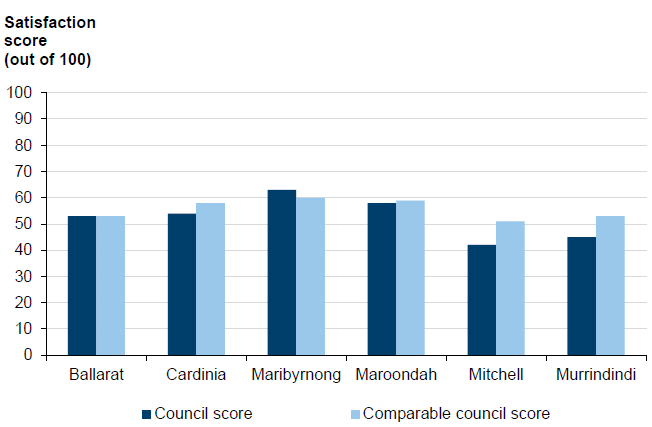
Source: VAGO, based on data from Know Your Council website, knowyourcouncil.vic.gov.au.
In 2015–16, four of the six audited councils scored lower than similar councils. Scores ranged from 42 to 63 out of 100. Mitchell and Murrindindi scored lowest and were well below similar councils, while Maribyrnong scored highest and was above similar councils.
Considering the relatively low scores, it would be beneficial for LGV to analyse the data and develop resources and initiatives that support councils to improve their practices.
3.5 Sector leadership
One of LGV's responsibilities is to demonstrate sector leadership by conducting better practice participation in its own activities. The following case studies show that LGV undertakes better practice public participation across all levels of the IAP2 spectrum, depending on the nature and needs of particular projects.
Victorian Aboriginal Local Government Action Plan
LGV developed the Victorian Aboriginal Local Government Action Plan during 2016. During the process, LGV conducted widespread consultation and incorporated feedback into the plan. The action plan recognises that local governments play a central role in closing the gap between Aboriginal and non-Aboriginal Victorians in key areas such as health, education and economic outcomes. The action plan is a resource for councils, and brings together some positive initiatives already happening around the state.
LGV prepared a consultation draft of the action plan and workshopped ideas with specific community groups to gain feedback from the public. LGV also requested case studies of better practice engagement and partnerships between councils and Aboriginal communities. LGV sent a copy of the consultation draft to key stakeholders and held a number of targeted workshops and meetings. LGV modified the action plan in response to concerns and queries raised by stakeholders and the community, by incorporating more specific information and actions.
This is an example of the Involve level of public participation—the objective was to work with stakeholders to ensure LGV understood and considered their concerns.
Local Government Model Financial Report
LGV is responsible for the annual review and update of the Local Government Model Financial Report (LGMFR) and associated better practice guide. LGV involved the community meaningfully in the process.
In preparing to update the documents for the 2015–16 reporting year, LGV consulted and engaged with the sector through three key channels—an online survey, a circular to all council CEOs and a workshop at the FinPro annual conference, an event for financial professionals in local government roles. Stakeholders provided 46 survey responses, six formal written submissions in response to the circular, and 26 comments and suggestions at the workshop.
LGV collated this feedback and formed a working group to consider, discuss and then approve any amendments for 2015–16. The working group included representatives from FinPro, CPA Australia, VAGO and LGV. It launched the updated LGMFR and better practice guide in February 2016 and held a series of five workshops throughout the state in May and June 2016.
Like the Victorian Aboriginal Local Government Action Plan, this case study represents the Involve level on the IAP2 spectrum.
Citizens' jury
Following an Independent Commission of Inquiry, the Victorian Parliament dismissed the Greater Geelong City Council in mid-2016.
The Parliament agreed that the people of Geelong should be given a say in the composition and representative structure of their new council. The Minister for Local Government (the minister) conducted a citizens' jury process to inform the development of the new representative structure. This is an example of empowering the local community—the fifth level on the IAP2 spectrum.
LGV commissioned an independent research organisation, the newDemocracy Foundation, to design and oversee the process on behalf of the minister. LGV prepared a background paper to help the jury in its deliberations. The newDemocracy Foundation sought submissions on alternative models of representation from academics and others to produce aspirational options for the jury to consider.
The 100 members of the citizens' jury were randomly selected and were representative of the gender, age and geographical diversity of Greater Geelong. The wider community contributed to the jury process through surveys, workshops and submissions. More than 1 000 people responded to the surveys, 29 submissions were received, and there were five public workshops and further targeted workshops involving 107 participants. The citizens' jury finalised its report in January 2017 and the government responded in March 2017.
LGV will commission an independent evaluation of the engagement activities in the citizens' jury project. The evaluation aims to capture and share the lessons learnt from the citizens' jury process as an example of a deliberative engagement process. This is particularly important as the proposed reforms to the Local Government Act 1989 will require councils to undertake deliberative engagement with their communities when they are developing their four-year council plans.
Appendix A. Audit Act 1994 section 16—submissions and comments
We have professionally engaged with Local Government Victoria (within the Department of Environment, Land, Water and Planning), the City of Ballarat, Cardinia Shire Council, Maribyrnong City Council, Maroondah City Council, Mitchell Shire Council and Murrindindi Shire Council throughout the course of the audit. In accordance with section 16(3) of the Audit Act 1994 we provided a copy of this report or relevant extracts to those agencies, and requested their submissions and comments.
Responsibility for the accuracy, fairness and balance of those comments rests solely with the agency head.
Responses were received as follows:
- Department of Environment, Land, Water and Planning
- City of Ballarat
- Cardinia Shire Council
- Maribyrnong City Council
- Mitchell Shire Council
- Murrindindi Shire Council
RESPONSE provided by the Secretary, Department of Environment, Land, Water and Planning
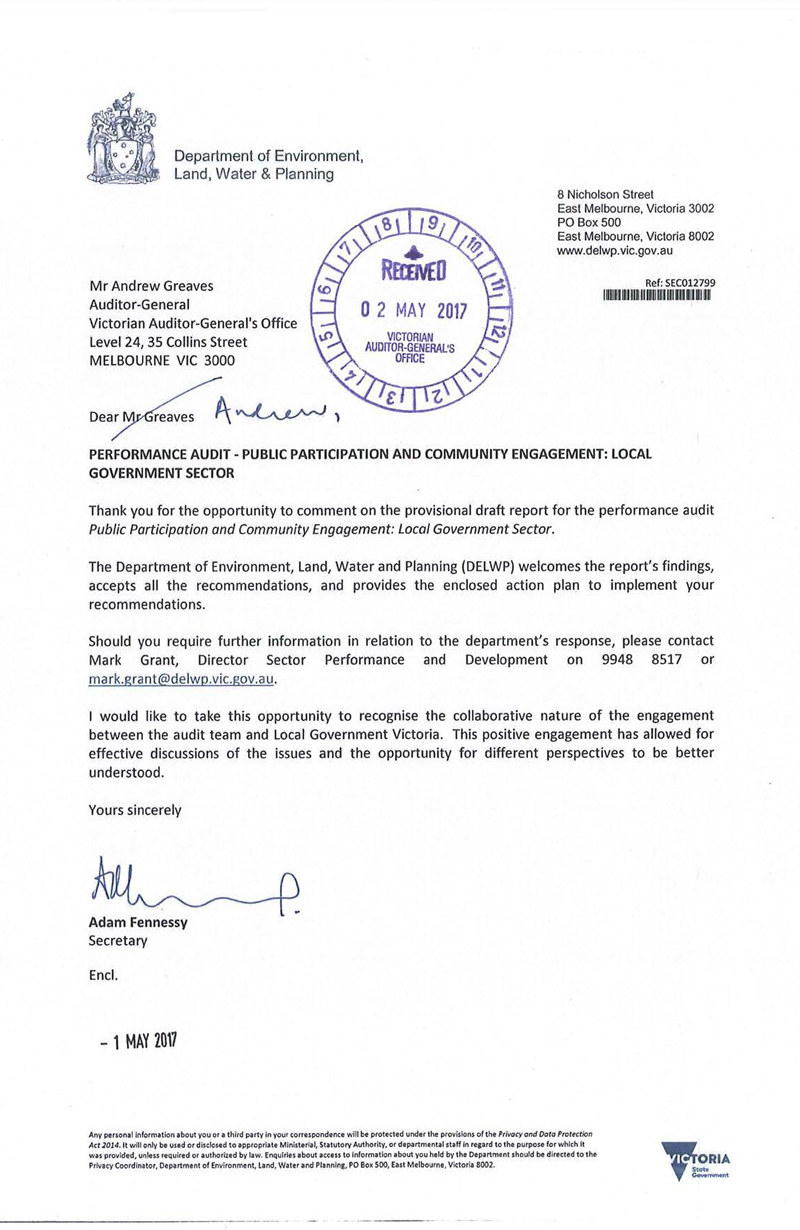
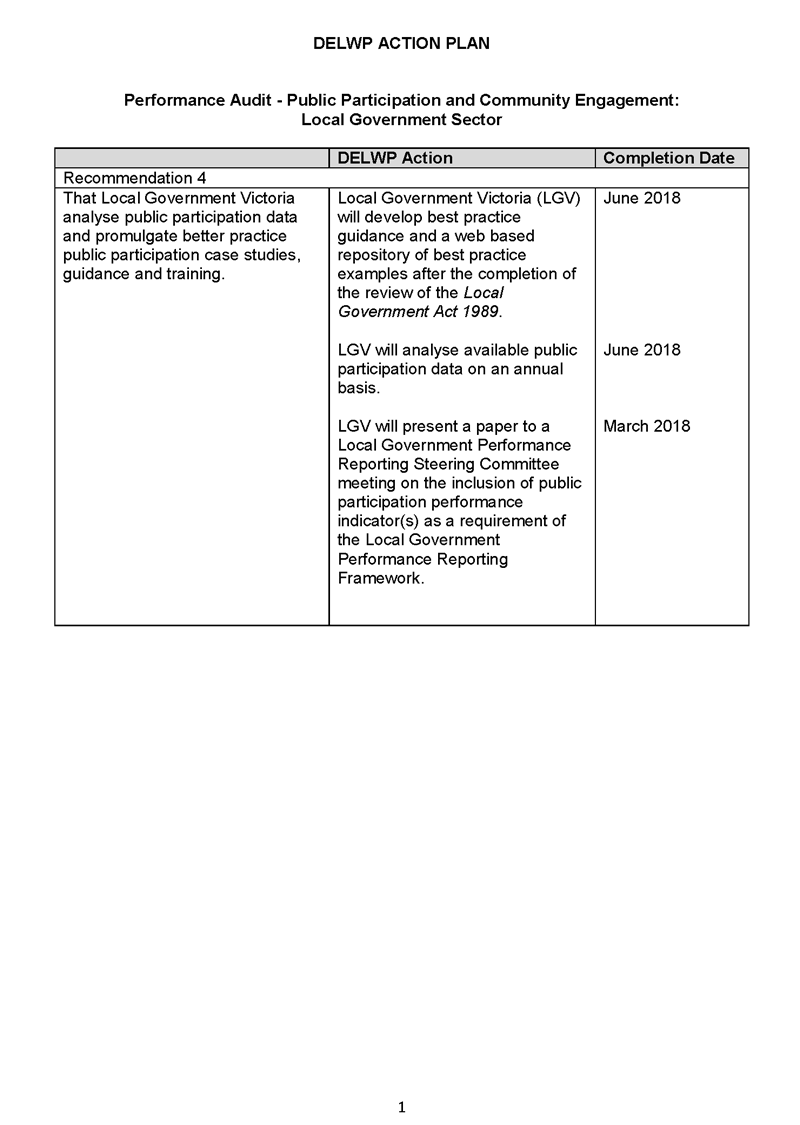
RESPONSE provided by the Chief Executive Officer, City of Ballarat
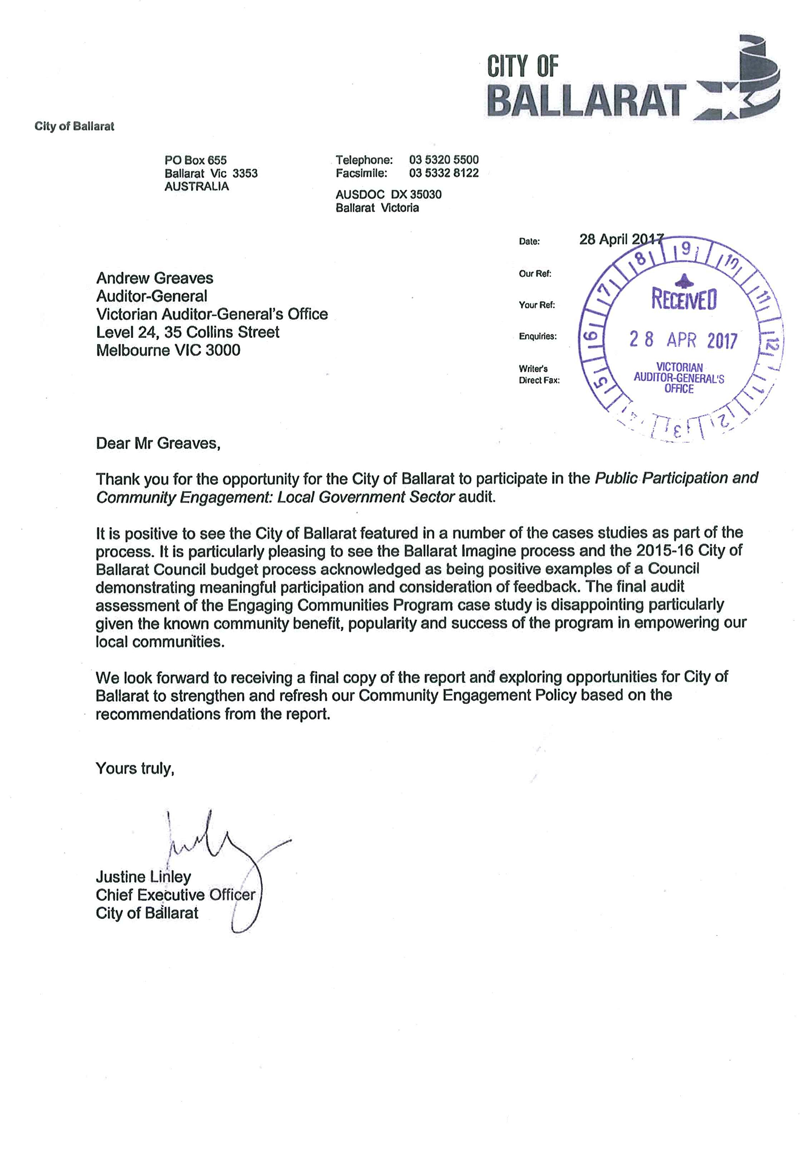
RESPONSE provided by the Chief Executive Officer, Cardinia Shire Council
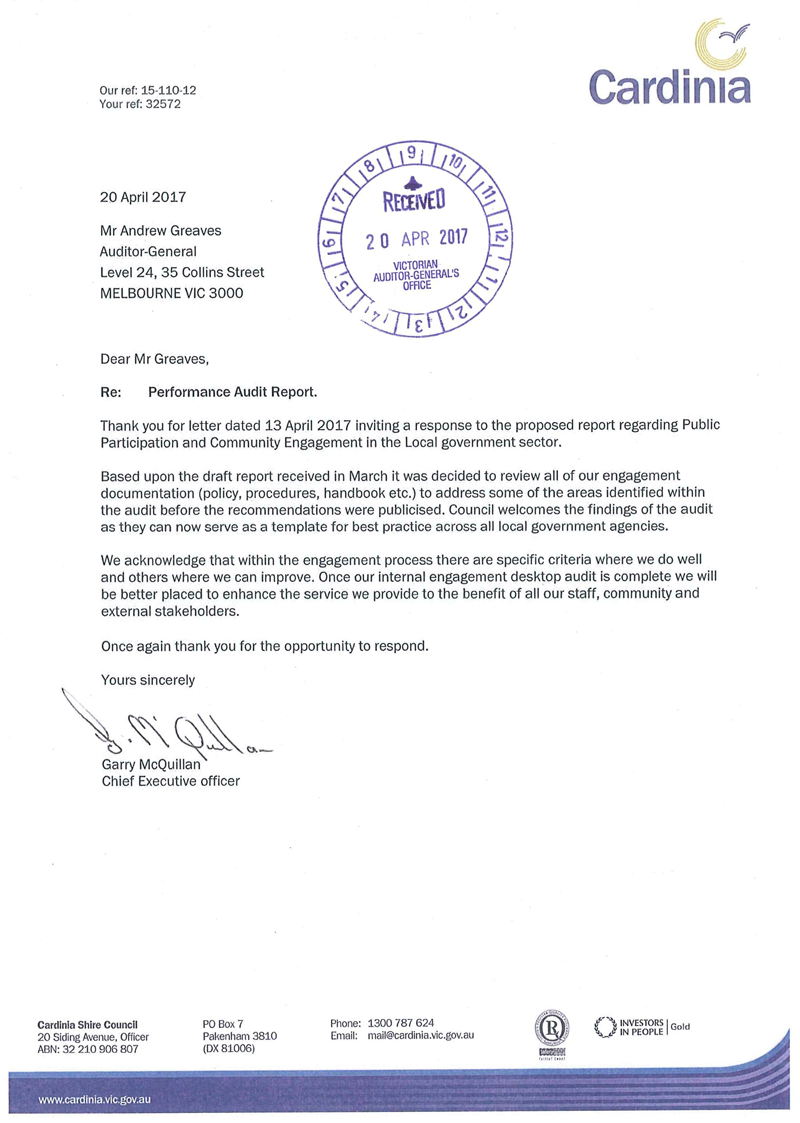
RESPONSE provided by the Chief Executive Officer, Maribyrnong City Council
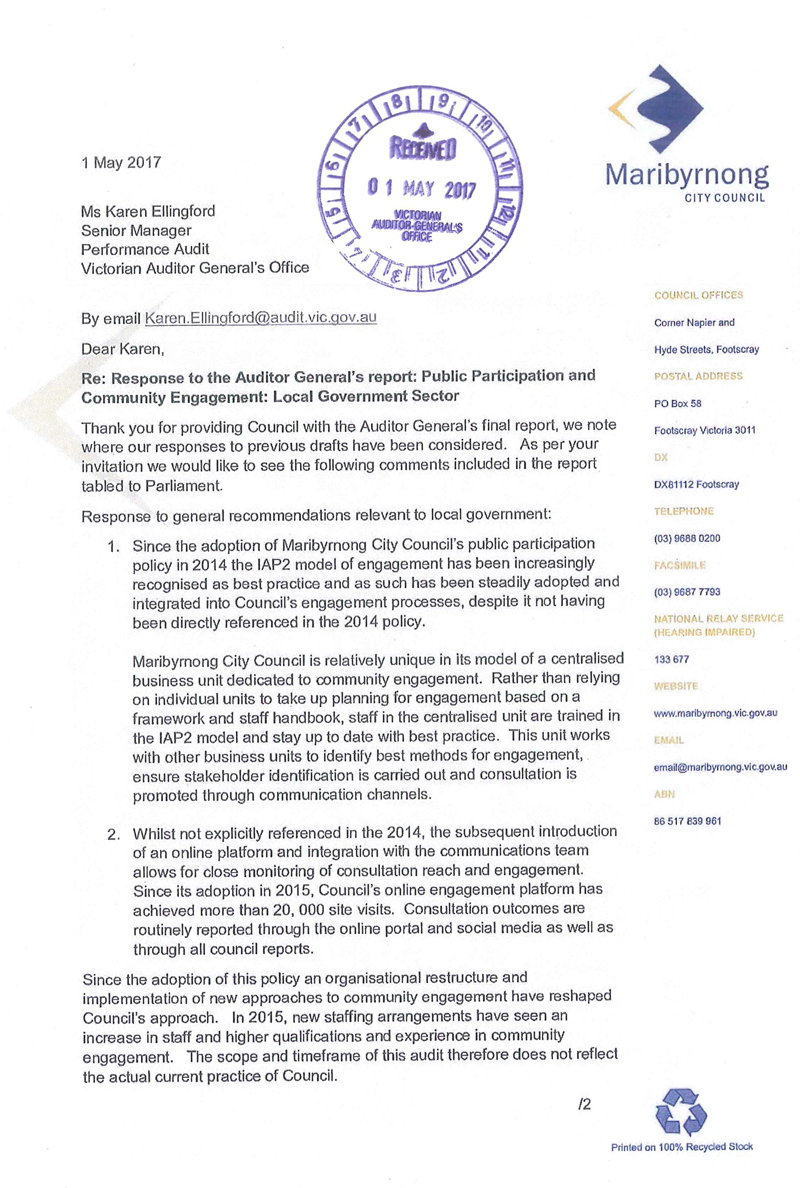
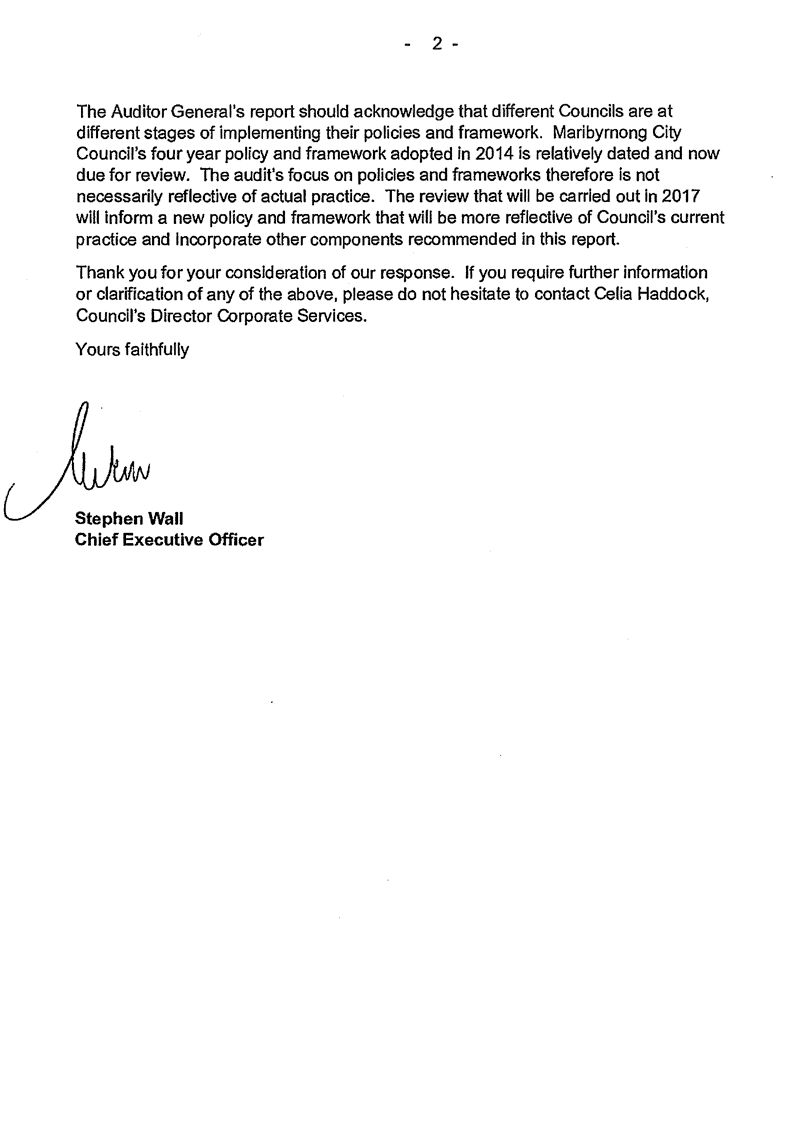
RESPONSE provided by the Chief Executive Officer, Mitchell Shire Council
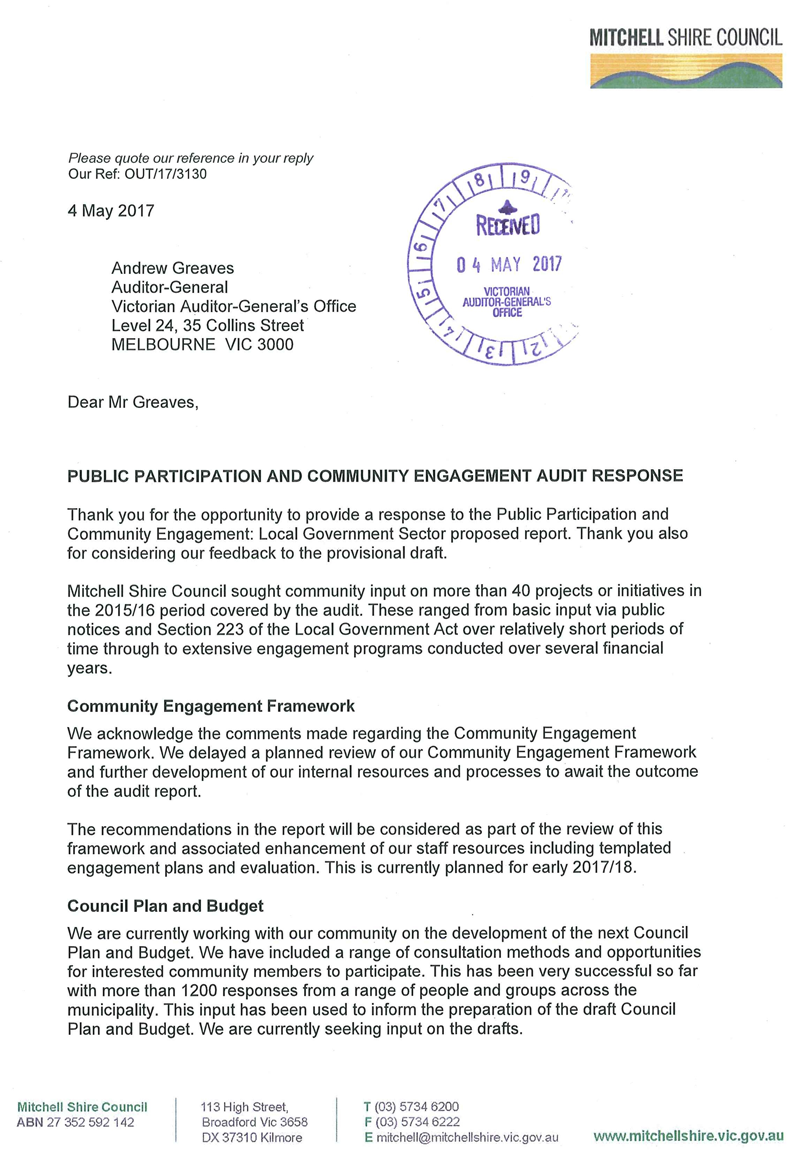
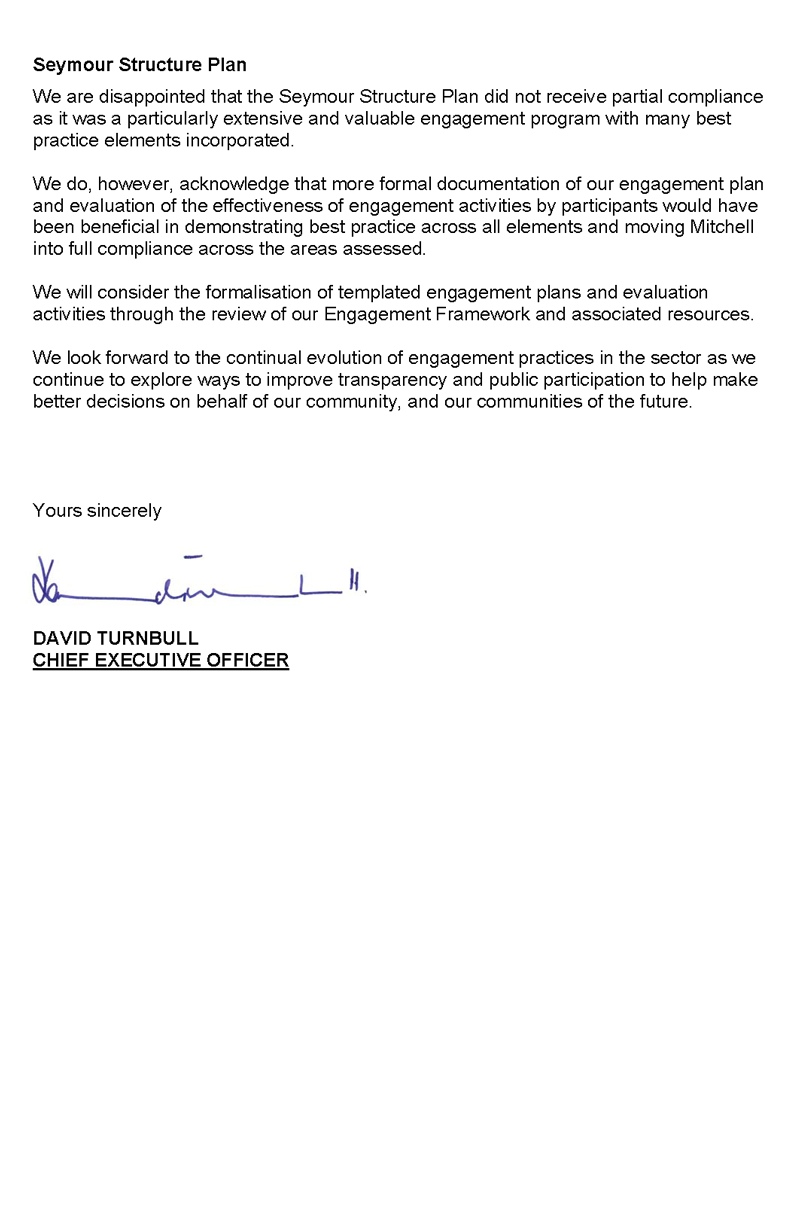
RESPONSE provided by the Chief Executive Officer, Murrindindi Shire Council
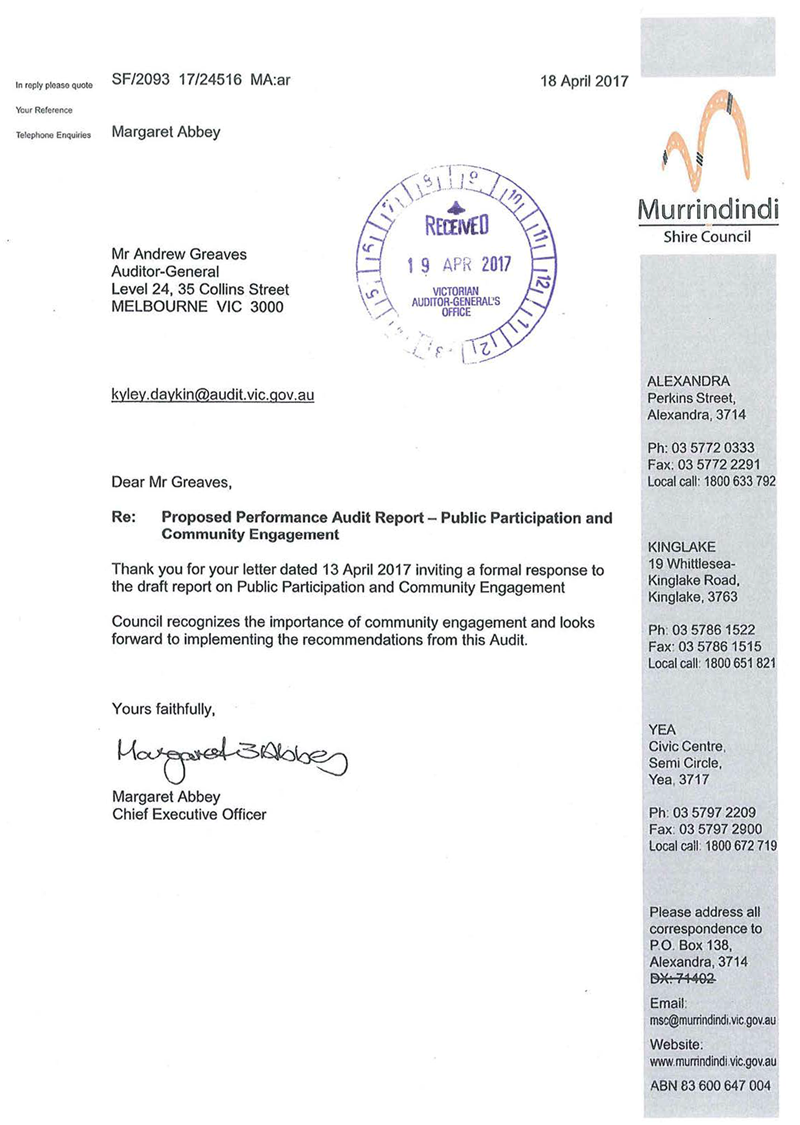
Appendix B. Better practice principles and resources for public participation
We compared the six audited councils' public participation policies and identified 12 common elements of better practice. Figure B1 describes each of these better practice elements.
Figure B1
Better practice elements in councils'
public participation policies and frameworks
Element |
Description |
|---|---|
Purpose |
Sets out a council's commitment to public participation |
Scope |
Identifies which business units, staff and activities are covered by the policy |
Objectives |
Sets out the aims of the policy in undertaking effective public participation |
Definitions |
Outlines definitions of key terms, such as engagement, community, consultation, stakeholder |
Responsibilities |
Identifies staff responsible for undertaking public participation |
International Association for Public Participation (IAP2) model |
Diagram and description of how the council adapts and applies the IAP2 model |
Principles and values |
The principles and values guiding public participation, such as transparent, inclusive, fair and responsive |
When to engage |
Circumstances when councils should engage, such as to help make decisions on current and emerging issues and on all major council plans, strategies and policies, and when it is a statutory, legislative or regulatory requirement |
How to engage |
Guidance on when to use the various engagement techniques, such as workshops, community meetings, local events, public exhibitions and submissions, website and social media, community and stakeholder reference group, surveys, mail-outs, advertisements |
Who to engage |
Identifies potential stakeholders, such as residents, business owners, ratepayers, community groups and clubs and those who work or participate in leisure activities in the municipality |
Monitoring, evaluation and review |
Outlines monitoring and review for all public participation activities, including qualitative and quantitative evaluation |
Engagement resources |
Lists the resources needed for community engagement, such as staff guides, policies, training, templates, online engagement tools and social media |
Source: VAGO.
We also assessed the audited councils' staff guides and handbooks for public participation against our better practice guide. We identified 15 common elements in councils' public participation resources for staff, described in Figure B2.
Figure B2
Typical elements in councils' public participation resources for staff
Element |
Description |
|---|---|
Community engagement checklist |
Engagement process checklist to ensure the engagement activity has been properly planned, or guidance on key stages of the public participation process |
Community engagement framework |
A model the council uses to underpin its public participation activities |
Community engagement planning |
Considers who needs to be engaged and how, what information needs to be presented, what questions asked and how the information will be collected, used and fed back |
Community engagement templates |
Document containing the structure of a typical engagement plan |
Engagement and communications plan |
Describes the engagement activity and the method to be used to collect and distribute information |
Engagement reporting |
A review of the engagement process, engagement methods, communication methods, evaluation methods, key findings, conclusions and recommendations |
Engagement tools and techniques |
Wide range of public participation resources |
Engaging hard-to-reach groups |
Techniques for reaching groups such as newly arrived people, older people, homeless people, Indigenous people, older migrants, children and young people |
Evaluation plan |
Plan for evaluating the community engagement process |
How to engage |
Broad range of methods for undertaking community engagement, such as workshops, community meetings, public exhibitions, submissions, social media, surveys, mail-outs, interviews |
IAP2 model |
Describes how the council applies the IAP2 model |
Stakeholder mapping |
Identifies stakeholder groups with an interest in the public participation activity |
Who to engage |
Identifies which stakeholders will be targeted by the public participation activity |
Why we engage |
Presents the rationale for engaging with the community |
When to engage |
Outlines the circumstances in which the council will engage |
Source: VAGO.
